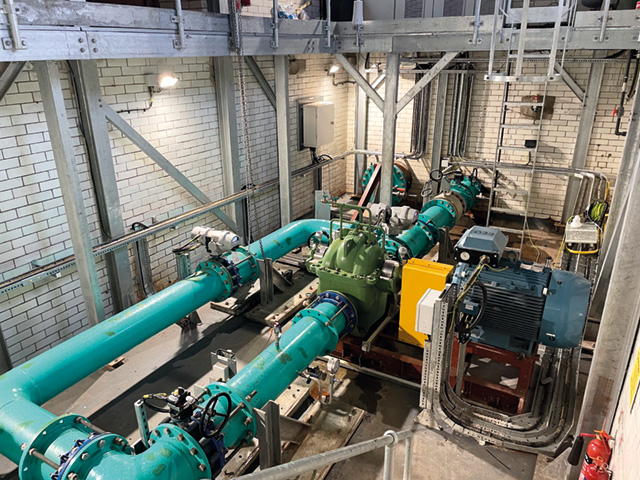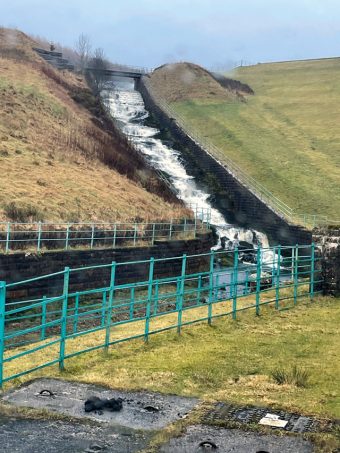
A renewable energy scheme is unveiled as part of upgrades to a Scottish reservoir. Torishima Service Solutions Europe Ltd, using an ABB generator and regenerative drive on their turbine have provided a scheme producing green energy which is returned to the grid.
A hydroelectric generation solution, comprising a reversiblepump turbine, generator, and regenerative variable speed drive (VSD), is installed at Lower Glendevon reservoir’s compensation measuring house, in a pilot scheme involving Torishima Service Solutions Europe Ltd (TSSE), Scottish Water and ABB. The installation produces enough renewable electricity to power some 100 homes in the local area, while fulfilling the reservoir’s primary purpose of providing the statutory minimum flow to the River Devon.
“In the first three months of operation, we have generated over 113,000kWh of electricity, which we have been able to return to the grid and puts us on course to save at least the equivalent of 93 tonnes of carbon dioxide annually,” says Tom Coutts, Senior Project Manager for TSSE.
When the reservoir at Glendevon is at full capacity, water spills over into the River Devon, via a spillway. A 15” outlet pipe is sized to deliver the desired minimum compensation flow of 242 litres per second (l/s), directly to the river, as stipulated by the Scottish Environment Protection Agency (SEPA).
The 15” pipe passes into the compensation measuring house where it connects to a reverse-pump turbine from Torishima Japan, which in turn powers an 85kW ABB asynchronous generator. When reservoir levels are high, a secondary 24” pipe becomes active, providing additional power generation capability. A 90kW ABB regenerative VSD converts the generator’s output into electricity suitable for transfer to the grid.

If the grid no longer needs additional electricity or a connection is lost, a separate brake chopper and resistance bank can be activated to divert the generated power and dissipate it as heat. Without them, a lost connection could cause the turbine and generator to accelerate to around twice their normal speed, which would then send surge waves back up upstream potentially damaging the old pipeline.
“A regenerative drive is the ideal solution for capturing energy and feeding it back to the grid, allowing flexibility on the variation on flow.” explains Jim Dow. “The drive requires simplified cabling which makes the installation quick. There are fewer components which improves the drive’s reliability and provides a smaller footprint, which helps optimise space.”
Scottish Water is benefitting from the integration of remote operation and monitoring at the facility. Previously, the team here faced 90-minute journeys to the site, which is in a remote location, so being able to control the valves and monitor real-time data around flow levels, temperatures and power generation remotely has proved to be beneficial.
Torishima’s solution, combined with ABB’s technology, is helping Scottish Water achieve its own Net Zero target by 2040. “Work began on the project in 2017 with a feasibility study, looking at many potential sites for hydro schemes. The installation at Lower Glendevon was effectively a trial and has proven the concept, which gives us the confidence to look at other sites where we can introduce this technology,” says Coutts. Currently, around 69 percent of the organisation’s carbon footprint is created through its electricity demands and it has identified 25 sites where renewable energy schemes can help off-set its energy usage.
“These schemes are, by their nature, weather-dependent so it can be difficult to accurately predict performance into the future,” adds Coutts. “We have been impressed with what we have seen so far though, which has given us confidence to start identifying other facilities where we can look at introducing renewable power generation.”
Jim Dow, Regional Sales Manager (Scotland) for ABB, adds; “The project at Lower Glendevon is a good example of how existing infrastructure, in this case the reservoir’s compensation measuring house, can be utilised to contribute towards Net Zero targets. While the scheme itself is relatively small, it proves the concept and highlights how ABB’s drive and motor technology can play an important role in the journey towards decarbonisation.”
www.abb.co.uk/energy | energy@gb.abb.com |
t: 01925 741111

